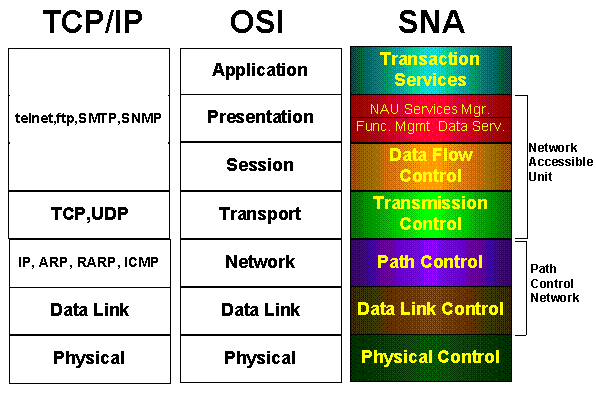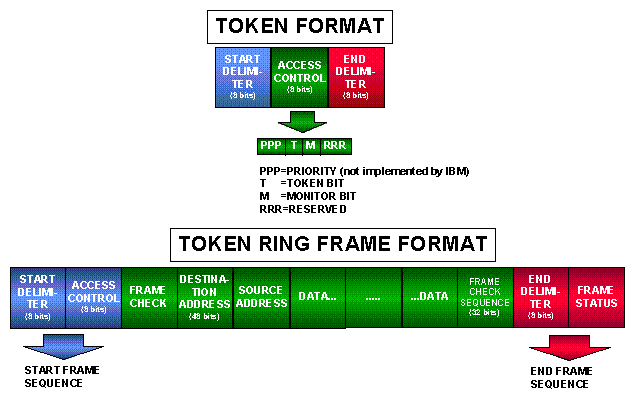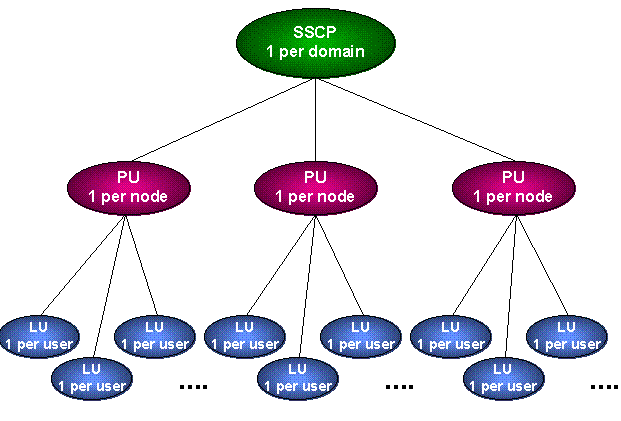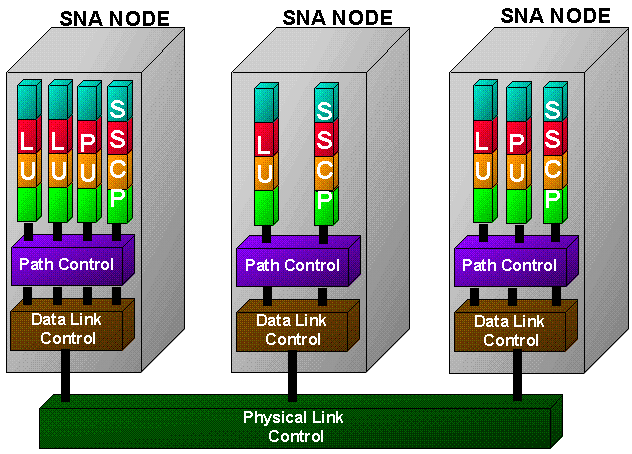- SNA is session-oriented: at any time, a terminal either is or is not in session with an application (much of SNA is concerned with session establishment and session-tracking).
- SNA is centralized: one entity, usually the MIS, keeps track of all system changes; a painstakingly thorough Configuration Management is required.
- SNA is asymmetric: to combine powerful mainframes and "dumb terminals", many internal protocols work differently from one device to another (e.g. LU).
- SNA is hierarchical: for one mainframe to be able to handle multiple terminals, other devices, such as concentrators or Front-End Processors (FEPs), are attached in between.
SNA model
The SNA hierarchical
architecture as defined by IBM as "a set of network addressable units
interconnected by an inner path control network." Given that models are a "best
attempt" to describe emerging theories or systems, but not necessarily an
accurate representation of reality, IBM has been attempting for almost a decade
to adjust SNA so that it can fit into the Open Systems Interconnect (OSI)
reference model. Despite the fact that during its existence SNA has been
modified a number of times to accomplish this, the following is represents its
latest attempt in doing so. Fig 1. SNA and TCP/IP correspondence to the OSI
reference model
* Physical: Undefined for SNA (although practically, for a number of years, Token Ring specifications were exclusively serving this purpose)
* Path control Network: consists of lower level components that control the
routing and data flow through the network; it is further subdivided into (fig
1):
- * Data Link Control: does frame construction and transmission error
recovery
* Path Control: responsible for routing and controlling congestion within a subnet.
* Network Addressable Unit (NAU) : a partner of a session, identifiable by network address as either origin or destination. It consists of the LU, PU and SSCP that reside in a single network device. Its services include configuration, session, management, directory, topology, routing services, the session and resources managers. Further subdivided into:
- * Transmission Control: creates, defines and manages sessions
* Data Flow Control: governs half-session priorities and error recovery.
* Function Management: performs services for the SNA user; further subdivided into:
-
- - Function Management Data Services
- NAU Services Manager
- - Function Management Data Services
* Application: Transaction Services
Token Ring
Until recently,Token Ring (TR), IEEE
802.5, was the preferred LAN contention scheme; now nearly all platforms are
supported over Ethernet IEEE 802.3. Some basic TR characteristics include:
* Differential Manchester DC encoding
* maximum theoretical throughput of 4 or 16 Mbps (with more than 1 token)
* physical topology is a "star", with the Multi-station Access Unit (MAU) at the "hub"; logical implementation is, of course, that of a ring Fig 2. The two basic Token Ring frame formats: the Token itself and a regular frame.
* supports two basic frame format (fig 2) [ICM, 1991]
* The control method for token ring is called Token Access. The token rotates clockwise or downstream in a ring from one workstation to the next. The design of TR guarantees that each station on the network has an opportunity to transmit at regular intervals by accessing the Token.
* Active Monitor (AM): monitors the token status by maintaining a master clock. If the token has been passed on for certain specific time, the AM will generate a new token, T, to continue the communications.
* Nearest Active Upstream Neighbor (NAUN): is the workstation that transmits the token when a hardware error occurs in a ring. * Beaconing: is a TR communication process that occurs when a ring station generates a warning signal onto the ring if it sees a hard error occur with itself or its NAUN.
* SNA routing: native routing scheme is fixed-path with manually predefined routes. It occurs among 37xx, between 37xx and mainframes, or among mainframes. Unlike typical routing, which occurs at the OSI Network Layer, SNA routing occurs in Layers 4 and 5 of the SNA stack [Special Issue-Network World].
In terms of the TR's future, there are currently four upgrade options [Guruge, 1994]:
* TR enhancements, such as switching or full duplex TR
* Fast Ethernet
* IEEE 802.12 100Base-VG/AnyLAN
* Asynchronous Transfer Mode (ATM)
SNA components
* NAU: Consists of the LU, PU and SSCP
that reside in a single network device.
* System Service Control Point (SSCP): provides the services needed to manage
an SNA network and to establish and control the interconnections that are
necessary to allow network users to communicate with one another; one per domain
(fig 3) .
Fig 3. SNA's hierarchical relationship between SSCP, PU and LU
.
Fig 3. SNA's hierarchical relationship between SSCP, PU and LU
* Physical Unit (PU): is used to represent the actual devices of the SNA network (e.g. controllers, terminals, etc.). A PU is implemented with some combination of hardware, software and firmware within the particular device that the physical unit represents; one per node. There four different types of PUs:
- * PU 1.0: obsolete
* PU 2.0: end node associated with minicomputers, 3274 controllers, Remote Job Entry (RJE) stations and some printers. Specifically, PU 2.1 allows for peer-to-peer connections
* PU 4.0: is a communications controller or FEP
* PU 5.0: is a host processor
* Logical Unit (LU): provides points of access through which users interact
with the SNA network, similar in concept to a port or socket which a user plugs
into. An LU is thus considered a virtual connection and each LU represents a
single user. LUs are implemented in software or firmware; there are 7 types,
each providing different transmission capabilities and a different set of
services; one per end-user (fig 4) . There are seven basic type
of LUs:
. There are seven basic type
of LUs:
- * LU 0: is product specific data stream for non-SNA 3270 and specialized
store-and-forward devices; suitable for either batch or interactive
environment. Fig 4: Example of SNA sessions depicting both SNA layers
(horizontally) and session types (vertically)
* LU 1: is for an application program that communicates with single or multiple devices using string character set (SCS) data stream such as 3767, 8100, JES RJE devices; suitable for batch, interactive or distributed data processing.
* LU 2: is for an application program that communicates with a single display terminal in an interactive environment, using 3270 data stream; primarily used for 3270 display device.
* LU 3: is for an application program that communicates with a printer, using 3270 data stream, such as a 3270 printer device; intended for an interactive environment
* LU 4: is for an application program that communicates with single or multiple-device and logical units in peripheral nodes that communicate with each other (predecessor of LU 6.2). It uses String Character Set (SCS) data stream and is suitable for batch, interactive or distributed data processing
* LU 6: is for an application subsystem that communicates with another application subsystem in a distributed processing environment; There are LU 6.1 and LU 6.2; the latter -the crown jewel of SNA- was designed to provide common set of protocols for peer-to-peer applications. It is also known Advanced Program-to-Program Communications (APPC)
* LU 7: is for S/3x to 5250 device; suitable for interactive environment and rarely used
Session types
* SSCP-to-SSCP: apply only to multiple
domains SNA network; are used to initiate and terminate cross-domain LU-to-LU
sessions.
* SSCP-to-PU : are used to transfer load and dump information.
* SSCP-to-LU : established for each LU when the network is initialized are used to establish an LU-to-LU session initiation and termination information
* LU-to-LU : are established dynamically; allow users to network and communication to each other.
* PU-to-PU: established to exchange network control information
Mainframe Links
* For close physical proximity, the link can be connected by an IBM cable of the FEP's I/O channels.
* For remote communication links, the link is implemented via a circuit using SDLC (Synchronous Data Link Control) protocols. The link could be point-to-point or multi-point. SDLC was described first by IBM in 1973, and is today compatible with the subset of ISO's High-level Data Link Control (HDLC).
SNA and TCP/IP
Altogether there are five alternatives for implementing distributed processing in an SNA environment. Four of them involve some combination of SNA and TCP/IP; the fifth, APPN, is covered in a separate section.
i) IP Encapsulation: places SNA traffic in IP format.
- Pros: Maintains existing hardware; minimizes router protocols.
Cons: Session time-outs; troubleshooting
ii) Enterprise Gateway: full 7-layer protocol conversion between SNA and TCP/IP.
- Pros: No router software changes; simpler to manage if properly deployed.
Cons: Some processing overhead
iii) Native TCP/IP: Adds TCP/IP protocol stack to the mainframe.
- Pros: No SNA needed; no gateways.
Cons: Expensive software
iv) AnyNet: IBM-developed middle-ware that implements TCP/IP sockets applications over SNA and vice-versa.
- Pros: separates network from applications.
Cons: No wide availability
Up until recently, each vendor's routers were using a different method of encapsulation, making multi-vendor compatibility impossible. This is about to change, with the emerging Data Link Switching (DLS, which is the result of RFC 1494). DLS establishes a standard method for making a router appear as an FEP to the SDLC line. In addition, its latest release due this month adds support for remote management via SNMP.
IBM also recently announced a licensing agreement with CNT/Brixton Systems, Inc. to provide AIX-based SNA servers that support both SNA and TCP/IP. One of the products, CNT/Brixton BrxPU2.1, will act as a gateway between TCP/IP and SNA backbone, by emulating a 3174 cluster controller to the SNA host and a TCP/IP host to the devices attached to the IP network. The other, BrxPU5, emulates a subset of VTAM and SNA host communication features, enabling the IBM 6000 to look like a mainframe.
In another effort to reduce the cost of its AIX OS (IBM's version of Unix), recently offered AIX v4.1. It now comes in separate client and server packages, with the client package requiring only half the RAM the server need [Cooneyc].
APPN
- Pros: Native SNA w/ known predictability and reliability.
Cons: Requires not yet available add-on to handle 3270 traffic.
It is the proclaimed SNA successor, with an ever more elusive target market. It uses LU6.2 (with peer-to-peer capabilities), but has not been met with success because of the TCP/IP factor. Other detrimental factors cited to the widespread deployment of APPN include high cost per node and security [Cooneyd]. Consists of Network Nodes and End Nodes (fig 4). Network nodes perform the following basic functions:
* Dynamic network topology
* Distributed directory
* Dynamic route selection
Fig 4 . Typical APPN network is made of End Nodes and Network Nodes
Source: IBM ITSO. The IBM 6611 Network Processor as a SNA/APPN Router
. Typical APPN network is made of End Nodes and Network Nodes
Source: IBM ITSO. The IBM 6611 Network Processor as a SNA/APPN Router
Also, an enhancement to the existing APPN routing is the already delayed High-Performance Routing (HPR), which IBM claims, can route around failures, has improved prioritization and increases performance by 30%. Recent lab tests showed APPN routers configured as Network Nodes achieved satisfactory results, (70-98% utilization of a T1 circuit, depending on frame size), provided the devices are properly configured [Cooneye].
Conclusion
To date, $20
trillion has been invested in SNA, worldwide. In the early 90's, IBM was
marketing itself as an OSI and TCP/IP integrator. However, OSI products from IBM
never materialized, and then markets and customers quickly switched over to
TCP/IP as the internetworking protocol of choice (greatly dictated by Internet
connectivity). IBM first tried SAA, APPN's predecessor, that never caught on.
Then, almost too late, and under customer pressure, begun actually offering
TCP/IP connectivity, while continue marketing the SNA successor, APPN.
In addition, IBM's most influential users' group (1,712 user organizations, including 98% of the Fortune 50), Share, Inc., began voicing their demands for improved multi-protocol, enterprise-wide systems management; increased recoverability, availability and serviceability of LAN-based products and improved security with single login and authentication check.
Those repeated failures to even follow the pace of the changing marketplace, were not lost on Wall Street. In the fall of '91 it decided that Big Blue's stock was overpriced and sent its price tumbling for $125 to about $80 and it has not recovered since (close 11/4: 701/8). The company has been forced through two major re-organizations, layoffs of tens of thousands of its employees, a CEO change and still unable -with the exception of a couple business units- to demonstrate improved financial discipline.
Today, almost unanimously, industry analysts agree with the assessment that SNA has entered critical crossroads. Despite its current widespread use among medium and large companies, its popularity and market share are declining fast, mainly due to proprietary technology and high life-cycle cost. Meanwhile, its designated successor, APPN, has been met with little success, as most companies are unwilling to invest in another similar technology to built their distributed systems; instead they prefer to extend SNA's life by running it over TCP/IP networks. The next two years will reveal how much clout IBM still maintains in the industry.
References
Cooneya, M. "IBM Users Call for Enterprise Management Tools, Survey Shows.", Network World, Vol 11, No 33, Aug 15, 1994, p 64
Cooneyb, M. "APPN Group Moves Technology Closer to Reality." Network World, Vol 11, No 28, July 11, 1994, p 13
Cooneyc, M. "IBM Brings AIX to Mainstream." Network World, Vol 11, No 31, Aug. 1, 1994, p 8
Cooneyd, M. "Aging SNA Faces a Fight for its Survival" Network World, Vol 11, No 36, Sep. 5, 1994, p 1
Cooneye, M. "APPN Technology Passes Initial Performance Tests." Network World, Vol 11, No 25, June 20, 1994, p 8
Cooneyf, M. "IBM Forges Unix Links to SNA Networks" Network World, Vol 11, No 38, Sept 19, 1994, p 6
Guruge, A. "More Than Token Solutions for User's LAN Blues.", Network World, Vol 11, No 37, Sept 22, 1994, p 66
Special Issue: "IBM Networking Update." Network World, Vol 11, No 24, June 13, 1994, p 49
Gaffin, A. "Internet's in and SNA's out" Network World, Vol 11, No 40, Oct 10, 1994, p 1
Higgins, K. J. "When Networking Worlds Collide." Open Systems Today, October 3, 1994, p 52
Castaldo, A., Flynn S. "Having Designs on SNA". LAN, September 1993, Vol 8, No 9, p 38.
Martin, J., Leben, J. Data Communication Technology. Englewood Cliffs , NJ: Prentice Hall. 1988
IBM International Technical Support Centers. The IBM 6611 Network Processor as a SNA/APPN Router. Research Triangle Park, NC: IBM ITSO. 1994 p 45.
IBM International Technical Support Centers. The Library for Systems Solutions, Open Networking Reference: A Business and Technical Perspective. Research Triangle Park, NC: IBM ITSO. 1994.
International Communcations Management, Inc. Data Communications II. Redmond, WA: ICM. 1991 (presentation material for Security Pacific)
Fitzgerald, J. Business Data Communications. NY, NY: John Wiley & Sons,
Inc. 1993